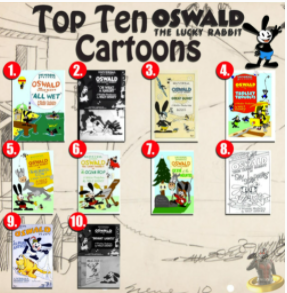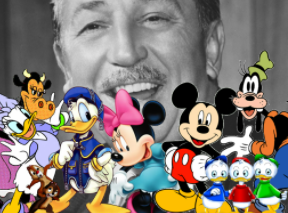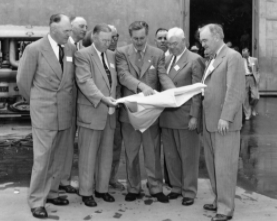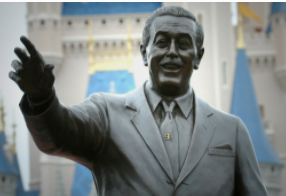Walter Elias Disney was an Amercan film producer director, screenwriter, voice actor, animator, entrepreneur and philantropist. Disney is notable as one of the most influential and innovative figures in the field of entertainment during the twentieth century.

Image source: https://search.creativecommons.org/photos/62a398e1-5c9e-4871-b387-cbbb578e4b35 by JeffChristiansen
Walt Disney founded the first modern media conglomerate, exploiting the ripeness of the children’s market as no one had before. Like today, where the latest computer animations are more important in selling a movie than the story line, Disney made bold, expensive risks to add impressive technological achievements to each film. Disney also pioneered the use of sound and color in motion pictures. His stable of fictional characters, which included Mickey, Minnie Mouse and Donald Duck, generated additional profit by appearing in advertisements, books and merchandise. Disney fare next appeared on television, another profit engine. In 1955, he launched Disneyland, the first theme park.
Info source: https://www.forbes.com/2005/07/20/disney-media-animation-cx_0720bizmandisney.html#68935f2a7e92
Walt Disney’s First Cartoon
In 1919, Disney moved to Kansas City to pursue a career as a newspaper artist. His brother Roy got him a job at the Pesmen-Rubin Art Studio, where he met cartoonist Ubbe Eert Iwwerks, better known as Ub Iwerks. From there, Disney worked at the Kansas City Film Ad Company, where he made commercials based on cutout animation. Around this time, Disney began experimenting with a camera, doing hand-drawn cel animation, and decided to open his own animation business. From the ad company, he recruited Fred Harman as his first employee. Walt and Harman made a deal with a local Kansas City theater to screen their cartoons, which they called Laugh-O-Grams. The cartoons were hugely popular, and Disney was able to acquire his own studio, upon which he bestowed the same name.

Image source: https://search.creativecommons.org/photos/6f4451c7-a9f3-4717-9e75-c12d01af54cf by AntMan3001
Disney and his brother Roy soon moved to Hollywood. Iwerks also relocated to California, and there the three began the Disney Brothers’ Studio. Their first deal was with New York distributor Margaret Winkler, to distribute their Alice cartoons. They also invented a character called Oswald the Lucky Rabbit.
Info source: https://www.biography.com/people/walt-disney-9275533
“That it was all started by a mouse”
A few years later, Disney discovered that Winkler and her husband, Charles Mintz, had stolen the rights to Oswald, along with all of Disney’s animators, except for Iwerks.
To replace Oswald, Disney and Iwerks developed Mickey Mouse, possibly inspired by a pet mouse that Disney had adopted while working in his Laugh-O-Gram studio, although the origins of the character are unclear. Disney’s original choice of name was Mortimer Mouse, but Lillian thought it too pompous, and suggested Mickey instead.
Iwerks revised Disney’s provisional sketches to make the character easier to animate, and Disney provided Mickey’s voice until 1947. In the words of one Disney employee, “Ub designed Mickey’s physical appearance, but Walt gave him his soul.”

Image source: https://search.creativecommons.org/photos/e6e29fbb-65da-4383-8674-6c3eceb9f74c by sbwoodside
Mickey Mouse first appeared in May 1928 as a single test screening of the short Plane Crazy, but it, and the second feature, The Gallopin’ Gaucho, failed to find a distributor. Disney used synchronized sound on the third short, Steamboat Willie, to create the first post-produced sound cartoon. In 1929, Disney created Silly Symphonies, which featured Mickey’s newly created friends, including Minnie Mouse, Donald Duck, Goofy and Pluto.
Disney studios signed a contract with Columbia Pictures to distribute the Mickey Mouse cartoons, which became increasingly popular, including internationally. Disney, always keen to embrace new technology, one of the most popular cartoons, Flowers and Trees, was the first to be produced in color and to win an Oscar.
Disney would also create his most successful cartoon short of all time, The Three Little Pigs, in 1933. The cartoon ran in theaters for many months, and also featured the hit song that became the anthem of the Great Depression, “Who’s Afraid of the Big Bad Wolf”.
The Golden Age of Animation

Image source: https://search.creativecommons.org/photos/9b581b6c-b4f3-45e7-8b56-5d7f34e4c9de by Dashu Pagla
Walt Disney began his most ambitious project to date. He wished to make a full length animated feature film of ‘Snow White and the Seven Dwarfs’. Many expected it to be a commercial failure. But, using new techniques of filming, the production was met with glowing reviews. It took nearly three years to film – coming out in 1937 after Disney had run out of money. But, the movie’s strong critical reception, made it the most successful film of 1938, earning $8 million on its first release. The film had very high production values but also captured the essence of a fairy tale on film for the first time. During the next five years, Walt Disney Studios completed another string of full-length animated films, Pinocchio (1940), Fantasia (1940), Dumbo (1941) and Bambi (1942).
World War II and Beyond
Shortly after the release of Dumbo in October 1941, the United States entered World War II. The U.S. Army contracted most of the Disney studio’s facilities and had the staff create training and instructional films for the military, home-front morale-boosting shorts such as Der Fuehrer’s Face and the feature film Victory Through Air Power in 1943. However, the military films did not generate income, and the feature film Bambi underperformed when it was released in April 1942.
By the late 1940s, the studio had recovered enough to continue production on the full-length features, Alice in Wonderland and Peter Pan, which had been shelved during the war years, and began work on Cinderella, which became Disney’s most successful film since Snow White and the Seven Dwarfs.

Image source: https://search.creativecommons.org/photos/4001f77a-508d-419c-804d-b3726a675c3d by Orange County Archives
The Disney studio was among the first to foresee the potential of television as a popular entertainment medium and to produce programs directly for it. Walt Disney’s Wonderful World of Color became a Sunday night fixture. The Mickey Mouse Club, a variety show featuring a cast of teenage performers known as the Mouseketeers, was also successful. The climax of Disney’s career as a producer, however, came with his release in 1964 of the motion picture Mary Poppins, which won worldwide popularity.
Disneyland, the First Theme Park
” You can design and create, and build the most wonderful place in the world. But it takes people to make the dream a reality.”
In the late 1940s, Walt Disney began building up plans for a massive Theme Park. Walt Disney wished the Theme Park to be like nothing ever created on earth. In particular, he wanted it to be a magical world for children . It was characteristic of Walt Disney that he was willing to take risks in trying something new.
After several years in the planning and building, Disneyland opened on July 17, 1955. Disney spoke at the address.
“To all who come to this happy place; welcome. Disneyland is your land. Here age relives fond memories of the past …. and here youth may savor the challenge and promise of the future. Disneyland is dedicated to the ideals, the dreams and the hard facts that have created America … with the hope that it will be a source of joy and inspiration to all the world.”

Image source: https://search.creativecommons.org/photos/bee5e7cf-a468-443e-858e-6a9d813d6b25 by dbking
The success of Disneyland encouraged Walt to consider another park in Orlando, Florida. In 1965, another theme park was planned. Within a few years of the opening, Disney began plans for a new theme park and to develop Experimental Prototype Community of Tomorrow (EPCOT) in Florida. It was still under construction when, in 1966, Disney was diagnosed with lung cancer. He died on December 15, 1966, at the age of 65. After his brother’s death, Roy carried on the plans to finish the Florida theme park, which opened in 1971 under the name Walt Disney World.
Info source: https://en.wikipedia.org/wiki/Walt_Disney
Info source: https://www.biographyonline.net/artists/walt-disney.html
Info source: https://www.britannica.com/biography/Walt-Disney
Info source: https://www.geni.com/people/Walt-Disney/6000000005291270001
Info source: https://www.biographyonline.net/artists/walt-disney.html
